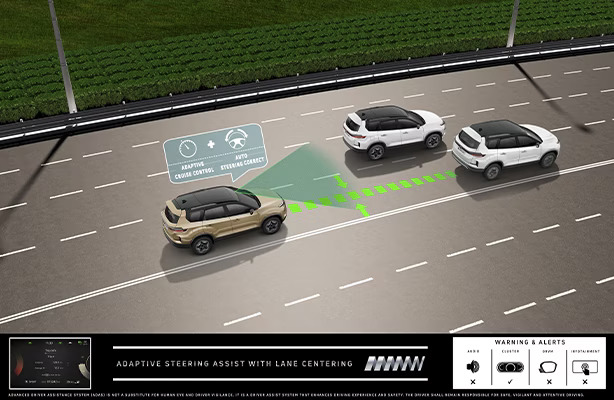Some stories write themselves. Others need the right roads, the right memories, and the right machine to come alive. The Tata Safari…
Some stories write themselves. Others need the right roads, the right memories, and the right machine to come alive. The Tata Safari is one such story. For many of us who grew up in the late ’90s and early 2000s, the original Safari wasn’t just an SUV – it was the SUV. A brawny, larger-than-life, proudly desi beast that dominated both driveways and imaginations.
Fast-forward to 2021, and Tata Motors resurrected the Safari nameplate — albeit with a twist. The new Safari rides on a front-wheel-drive monocoque chassis, based on the OMEGA ARC platform shared with the Harrier.

As a fanboy, I’ll admit — I was skeptical during the launch in 2021. The silhouette was imposing, sure. But where was the rear-wheel drive? The ladder frame? The old-school thunder? But after living with the facelifted 2023 Tata Safari for five days and clocking over 1,000 km across highways, cities, and hills, skepticism gave way to admiration. The 8-year-old in me, who once drooled over the OG Tata Safari commercials, had finally come full circle.
This review isn’t just about numbers and features — it’s about rediscovery. It’s about understanding what makes the modern Safari tick, and why it still has the power to charm both nostalgic hearts and new-age drivers.
Styling and Presence: Safari still owns the road
One of the first things you notice when you approach the 2023 Tata Safari is that it looks like a real SUV. Not a jacked-up hatchback. Not a crossover playing dress-up. It’s big, bold, and doesn’t shy away from flexing its presence.

The facelift brings a more confident and evolved face. The vertical LED headlamp stack with Matrix-like DRLs looks sharp. The grille? Bigger, bolder, and blingier. The 19-inch alloys are muscular, almost armored in design, and the side profile, with its floating roof effect and generous rear overhang, quietly hints at the three-row seating inside.


The chrome elements are tastefully done, and the rear, with its connected LED taillamps, adds a sleek touch of modernity without betraying the Safari’s DNA.

It’s a masterclass in evolutionary design. While competitors are rounding out their edges to look more “urban,” the Safari stays macho. It looks expensive, confident, and unapologetically Indian. And that visual presence matters in this segment.
Whether it was the streets of Pune, the long NH48 stretches, the curvy Lavasa ghats, or sleepy villages in Maharashtra, heads turned, cameras came out, and conversations started. Not every car does that. But the Safari? Oh, it does.
Interior: Plush, spacious, and purposeful
Step inside, and the transition from rugged roots to refined luxury is immediate. Tata’s done a fabulous job with the cabin. Our test car — the Accomplished + 6S with the 6-seat layout — came with captain seats in the middle row.

The Oyster White and Titan Brown interior theme, accented with tasteful wood inserts, feels premium. The seats are plush and supportive, and finally, the Safari’s cabin feels like it belongs in a league with the Mahindra XUV 700, Toyota Innova HyCross, MG Hector Plus, Kia Carens, and Hyundai Alcazar.


The ventilated seats in the first and second rows were absolute lifesavers during our sun-soaked highway stints. Add in a powered driver’s seat with memory, an auto-dimming IRVM, and a powered tailgate, and suddenly, the Safari feels more convenience-focused than ever before. What adds an extra layer of pampering, especially for chauffeur-driven passengers, is the Boss Mode — a touch of a button on the second-row seat lets you slide the front passenger seat forward for more legroom and lounge-like comfort.





The dashboard layout is anchored by a crisp 10.25-inch digital cluster and a slick 12.3-inch touchscreen infotainment system. It finally feels modern, intuitive, and premium. The JBL 10-speaker system delivers impressive audio, and wireless Android Auto and Apple CarPlay (finally!) complete the tech package.

Tata hasn’t ignored the little things, either: USB-C ports in all three rows, cooled storage under the front armrest, large door pockets, ambient lighting, and a massive panoramic sunroof all add to the sense of thoughtful indulgence.

And the third row? Surprisingly usable. With a sliding middle row and a cleverly scooped roofline, adults under 5’10” can manage short trips in relative comfort. One of my co-passengers, Karan (5’9”), managed fine in the back. Sure, there was a bit of comedy during ingress and egress, but he quickly calmed down once he spotted the rear AC vents, USB-C port, and cupholders. Sometimes, a well-placed convenience feature is all it takes to silence the grumbles.

Engine and Transmission: Familiar but finessed
Under the hood sits Tata Motors’ 2.0-litre Kryotec diesel engine sourced from Stellantis — good for 167.7bhp and 350 Nm. It’s mated to a 6-speed torque converter automatic sourced from Hyundai.

No, it’s not a performance SUV — and it doesn’t try to be one. There’s a bit of turbo lag under 1,500 rpm, but post that, there’s a healthy surge of torque that pulls confidently up to about 3,750 rpm.

The gearbox isn’t the quickest — shifts are smooth but relaxed. Push hard and it’ll respond, albeit on its own terms. But for real-world use — city errands, highway cruising, hill climbs — the combo is well-sorted and stress-free.
Over 1,000+ km of mixed driving — traffic snarls, expressway blasts, village backroads — the Safari never missed a beat. Triple-digit cruising? Easy. Hill overtakes? Composed. Slow-moving traffic? Effortless.
There’s a strangely satisfying calm in how this SUV delivers power — you sit high, ride smooth, and feel like you’re gently gliding through chaos.
Ride and Handling: Comfort is king
The Safari’s ride quality is easily one of its biggest strengths. Tata has fine-tuned the suspension for comfort, and it delivers — whether you’re crawling over potholes or blasting down a highway.

The reworked front struts and rear torsion beam setup offer excellent rebound and damping. We hurled this SUV through potholes, patchy village roads, and twisty hill sections — it just soaked it all up.

At highway speeds, it feels almost European in its composure. There is some body roll — you can’t fight physics — but it’s controlled and predictable. The switch to an electric power steering unit has made low-speed maneuverability a breeze. And the 360-degree camera setup? Game-changer for city parking.
Lighting and night driving experience: Looks good, works even better
There’s been chatter online about Safari’s lighting performance — but after multiple night drives through unlit ghats and highways, I can safely say: it’s largely a myth.

The projector LED headlamps, combined with the DRLs and high beams, offer excellent throw and spread. Visibility was sharp, confidence-inspiring, and consistent — even in foggy stretches.
If you’re struggling with dim lights, a simple headlamp alignment or software update might fix the issue. But in our experience, the setup was more than adequate.
ADAS and Safety tech: Brave new world
The latest Safari brings Level 2 ADAS features to the table — a big leap for Tata in the safety game. Here’s what you get:
- Forward Collision Warning
- Autonomous Emergency Braking
- Lane Departure Warning
- Blind Spot Monitoring
- Rear Cross Traffic Alert
- Door Open Alert


These systems work well on highways and open roads. But in Indian city traffic, especially in places like Pune or Mumbai, the emergency braking can be a tad overenthusiastic. A few two-wheelers weaving too close can trigger alerts or light braking.

Thankfully, most features can be toggled off or tweaked. But as ADAS adoption grows, tuning it to Indian driving behavior will be key.




In terms of safety, the Safari is rock solid — 6 airbags, ABS, ESC, all-wheel disc brakes, ISOFIX mounts, and a 5-star Global NCAP crash rating. Tata’s commitment to occupant protection is evident in the build quality and safety kit.
Fuel efficiency: Makes sense for the miles
Over five days of mixed driving, we averaged between 12.5 to 14.2 kmpl in regular mode. On highways with cruise control and a light foot, we even breached 15.5 kmpl. In heavy traffic with AC on max, it dipped to around 10.3 kmpl.
With a 50-litre tank, that translates to a real-world range of 600–750 km. That’s impressive for a full-size, torque-rich diesel SUV.
Pricing: Worth the stretch?
The Tata Safari range starts at ₹15.49 lakh (ex-showroom Delhi) and goes up to ₹25.09 lakh for the top-end automatic variants. Our test car, the Accompished + 6S, 6-seater variant, is priced at around ₹25.09 lakh (ex-showroom) in Mumbai as well.

Yes, that’s a serious chunk of change. And yes, rivals like the Mahindra XUV700 offer AWD and more power. But the Safari balances heritage, street cred, cabin space, and feel-good factor in a way that’s hard to match.
It’s not just a car. It’s a conversation starter.
Verdict: The legend grows up and it’s glorious
Five days. Over 1,000 km. Every kind of road. And one clear conclusion: the Tata Safari is no longer just a nameplate. It’s a movement — matured and modernized.
It revives the charm of the original, sprinkles in tech and luxury, and still manages to deliver that old-school SUV character in a contemporary, comfortable avatar.

For the 2000s kids, it’s a high-five from your childhood. For new-age buyers, it’s a feature-rich, commanding, family-friendly SUV with soul.
Is it perfect? No. The gearbox could be snappier. The ADAS could be smarter. And it’s not exactly cheap.
But what it gives you — in experience, presence, and pride — is more than the sum of its parts.
Photography: Ali Asgar Karmawala and Anup Lakra for DAG India. Select technical visuals sourced from the official Tata Motors media library.

